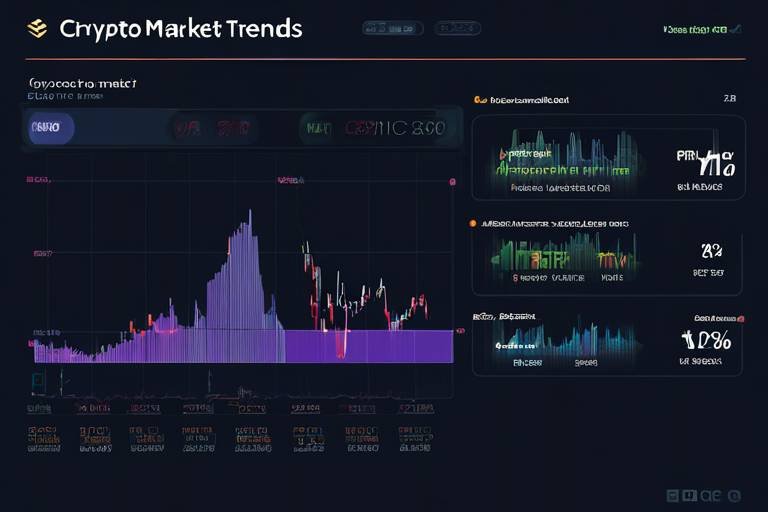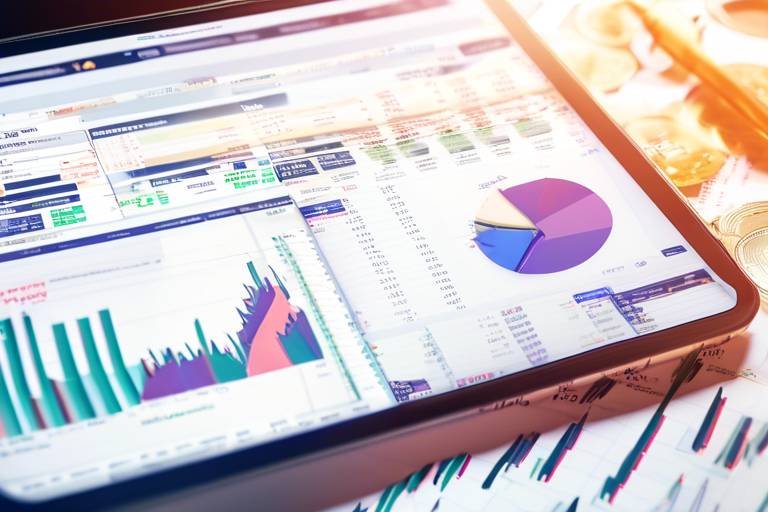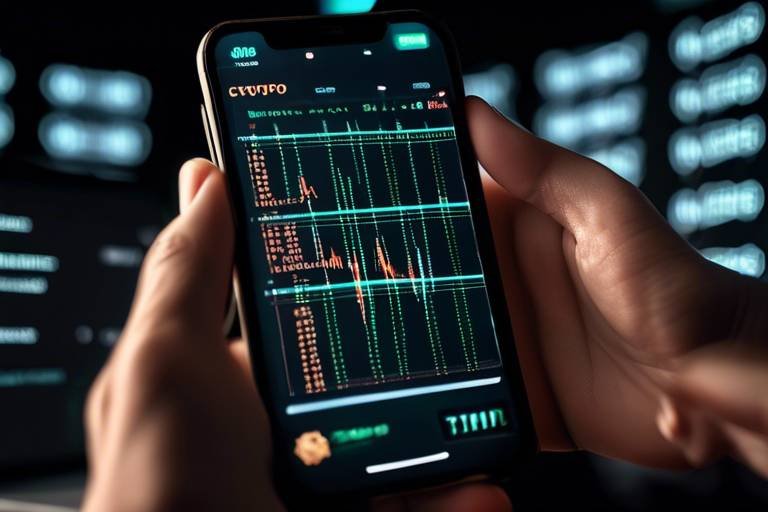How to Trade Cryptocurrency Using Price Action
In the ever-evolving world of cryptocurrency trading, the ability to make informed decisions quickly can be the difference between profit and loss. One of the most effective methods for achieving this is through price action analysis. This technique allows traders to interpret market movements based solely on historical price data, rather than relying on complex indicators or algorithms. Imagine standing on the edge of a bustling market, observing the ebb and flow of buyers and sellers; this is what price action trading embodies. By understanding the underlying principles of price movements, traders can gain insights into market sentiment and make strategic decisions that align with the current market dynamics.
Price action trading is not just about reading charts; it’s about understanding human behavior. Every price movement tells a story, reflecting the emotions and decisions of countless traders. This method strips away the noise of technical indicators and focuses on the raw data—price itself. For those new to trading, this approach can feel refreshing and liberating, as it emphasizes simplicity and clarity. By honing in on price action, traders can develop a keen sense of timing, which is crucial in the fast-paced world of cryptocurrencies.
As we delve deeper into the nuances of price action trading, it’s essential to recognize that the foundation of this strategy lies in identifying key patterns and trends. These patterns serve as the roadmap for traders, guiding them through the volatile landscape of cryptocurrency markets. Whether you’re a seasoned trader or just starting out, mastering price action can significantly enhance your trading effectiveness. So, grab your charts, and let’s explore the exciting world of price action trading together!
Price action trading focuses on historical price movements, allowing traders to make decisions based on market behavior rather than indicators. This section discusses the principles of price action and its significance in cryptocurrency trading.
At its core, price action is about interpreting the market's past to forecast its future. It’s akin to reading a book where each candle on the chart tells a part of the story. By analyzing these candles, traders can decipher whether the market is likely to continue in its current direction or reverse course. This ability to read the market's narrative is what sets successful traders apart from the rest.
Understanding price action also involves recognizing the psychology of trading. The cryptocurrency market is notoriously volatile, often driven by fear and greed. By paying attention to price movements, traders can gauge market sentiment and make decisions that align with the prevailing mood. For instance, a sudden price spike might indicate a rush of buying interest, while a sharp drop could signal panic selling. By being attuned to these shifts, traders can position themselves advantageously.
Identifying price action patterns is crucial for successful trading. This section covers common patterns like pin bars, engulfing candles, and inside bars that can signal potential market reversals or continuations.
The pin bar reversal pattern indicates a potential reversal in price direction. This subsection explains how to recognize pin bars and their implications for trading decisions.
Recognizing pin bars involves analyzing candle shapes and their position within the price chart. A pin bar typically has a long wick and a small body, indicating that the market attempted to move in one direction but ultimately reversed. Think of it as a rubber band being stretched—when it snaps back, it often leads to a significant price movement. Spotting these formations can give traders an edge in predicting market reversals.
This section outlines strategies for entering and exiting trades based on pin bar signals, enhancing the trader's ability to capitalize on market movements. For instance, a trader might enter a long position after a bullish pin bar appears at a support level, signaling a potential upward movement. Conversely, a bearish pin bar at a resistance level could indicate a good opportunity to short the market. By implementing these strategies, traders can harness the power of pin bar signals to maximize their trading success.
Engulfing candle patterns are powerful indicators of market sentiment changes. Here, we delve into the bullish and bearish engulfing patterns and their significance for traders.
Support and resistance levels are critical for price action trading. This section explains how to identify these levels and their importance in making informed trading decisions.
Properly drawing support and resistance lines on your charts can help you anticipate price movements. This subsection provides techniques for accurately identifying these levels. Support levels act as a safety net for prices, while resistance levels serve as ceilings that prices struggle to break through. By marking these levels on your charts, you can better understand where potential reversals or breakouts may occur.
Incorporating support and resistance into your trading strategy can enhance risk management. This part discusses how to use these levels effectively for entry and exit points. For example, traders often look for buying opportunities near support levels and selling opportunities near resistance levels. This approach not only helps in making informed decisions but also aids in managing risk effectively.
- What is price action trading? Price action trading focuses on historical price movements to make trading decisions without relying on indicators.
- How do I identify key price action patterns? Look for specific formations such as pin bars, engulfing candles, and inside bars on your charts.
- Why are support and resistance levels important? They help traders identify potential reversal points and make informed entry and exit decisions.
- Can beginners use price action trading? Absolutely! Price action trading is straightforward and can be learned by anyone willing to study price movements.

Understanding Price Action
When it comes to trading cryptocurrencies, understanding price action is like having a map in a vast, uncharted territory. Imagine trying to navigate a maze without knowing where you're going. Price action trading focuses on the historical movements of prices, allowing traders to make informed decisions based on actual market behavior rather than relying solely on technical indicators. This approach emphasizes the importance of understanding how price reacts to various market conditions, which can be especially volatile in the world of cryptocurrencies.
At its core, price action trading is about observing the naked price chart. This means looking at the price movements without any clutter from indicators. Why is this significant? Because indicators are often lagging, meaning they react to price movements rather than predict them. Price action, on the other hand, provides real-time insights into market sentiment. For example, when a significant price movement occurs, it can indicate a shift in trader psychology, which is crucial for making timely trading decisions.
One of the key principles of price action trading is that all information is reflected in the price. This means that fundamental news, market sentiment, and trader behavior are all encapsulated in the price movements you observe. Think of it as a reflection of the collective emotions and actions of all market participants. By focusing on price action, traders can gain a clearer understanding of the current market dynamics and make more educated guesses about future price movements.
Another important aspect of price action is its adaptability. Traders can apply price action strategies across various time frames, whether they are day trading, swing trading, or investing long-term. This flexibility allows traders to tailor their strategies to fit their unique trading styles and goals. For instance, a day trader may look for quick price movements within a single day, while a swing trader might focus on capturing larger trends over several days or weeks.
To effectively utilize price action in cryptocurrency trading, traders often look for specific patterns and formations that can signal potential price reversals or continuations. These patterns are like breadcrumbs that guide traders toward potential opportunities. Some of the most common patterns include:
- Pin Bars: Indicate potential reversals with long wicks.
- Engulfing Candles: Signal shifts in market sentiment.
- Inside Bars: Suggest periods of consolidation before a breakout.
By honing in on these patterns, traders can make more strategic decisions about when to enter or exit trades. It's essential to combine price action analysis with good risk management practices to protect your capital. After all, no trading strategy is foolproof, and the cryptocurrency market can be notoriously unpredictable. Therefore, understanding the fundamentals of price action can significantly enhance your trading effectiveness.
In summary, mastering price action trading opens up a world of possibilities for cryptocurrency traders. It empowers you to read the market like a book, making you more adept at spotting potential opportunities and minimizing risks. So, if you're ready to dive deeper into the world of crypto trading, understanding price action is the first step on your journey to success.

Key Price Action Patterns
When it comes to trading cryptocurrencies, understanding key price action patterns is like having a secret map to treasure. These patterns serve as vital clues that help traders predict potential market movements. By recognizing these patterns, traders can make informed decisions that can significantly enhance their chances of success. Let’s dive into some of the most common and impactful price action patterns you should be aware of!
One of the most essential patterns is the pin bar. This pattern is characterized by a small body with a long tail, resembling a pin. It typically indicates a potential reversal in price direction, making it a crucial signal for traders looking to enter or exit positions. But how do you spot a pin bar? Well, it’s all about the candle’s shape and its position on the chart. A pin bar forms at key support or resistance levels, which adds to its significance.
Next up, we have the engulfing candle pattern. This powerful pattern occurs when a smaller candle is completely engulfed by a larger candle. It can signal a strong shift in market sentiment. There are two types to be aware of: the bullish engulfing pattern, which suggests a potential upward trend, and the bearish engulfing pattern, indicating a possible downward trend. Recognizing these patterns can be a game-changer for your trading strategy.
Lastly, we can’t forget about the inside bar. This pattern consists of a smaller candle that forms within the range of the previous candle, suggesting a period of consolidation. Inside bars often precede significant price movements, making them valuable for traders who are looking to capitalize on breakouts. By keeping an eye on these patterns, you can better position yourself to make profitable trades.
| Pattern | Description | Trading Implication |
|---|---|---|
| Pin Bar | A small body with a long wick indicating potential reversal. | Enter a trade in the direction of the wick after confirmation. |
| Engulfing Candle | A larger candle fully engulfs a smaller one, indicating sentiment shift. | Trade in the direction of the engulfing candle. |
| Inside Bar | A smaller candle within the previous candle's range, indicating consolidation. | Prepare for a breakout in either direction. |
Understanding and identifying these key price action patterns can significantly elevate your trading game. Just like a skilled detective, you need to pay attention to the clues the market provides. By mastering these patterns, you’ll be better equipped to navigate the often turbulent waters of cryptocurrency trading.
In conclusion, the world of cryptocurrency trading is filled with opportunities, but it’s essential to have the right tools and knowledge at your disposal. Price action patterns are among the most effective tools that traders can use to make educated decisions. So, keep your eyes peeled for these patterns, and you might just uncover some hidden gems in your trading journey!
- What is price action trading? Price action trading focuses on historical price movements and market behavior instead of relying heavily on indicators.
- How do I identify a pin bar? A pin bar has a small body and a long tail, typically found at key support or resistance levels.
- What does an engulfing candle pattern indicate? An engulfing candle pattern signals a potential change in market sentiment, with bullish patterns suggesting upward movement and bearish patterns indicating downward movement.
- Are inside bars reliable for trading? Yes, inside bars can indicate periods of consolidation and often precede significant price movements, making them valuable for breakout trading strategies.

Pin Bar Reversal
The is one of the most recognized patterns in price action trading, and for good reason. It serves as a beacon for traders, indicating potential reversals in price direction. Imagine standing at the edge of a cliff, looking down at the waves crashing below; that’s what a pin bar can signal—a change in the tide. The beauty of this pattern lies in its simplicity and effectiveness, making it an essential tool in any trader's arsenal.
To understand the significance of pin bars, it's crucial to recognize their unique structure. A pin bar typically consists of a small body with a long wick, which can either point upwards or downwards. This formation suggests that the market tried to push the price in one direction but ultimately failed, leading to a reversal. When you see a pin bar forming, it’s like witnessing a dramatic plot twist in a movie—everything you thought you knew about the market could suddenly change.
Pin bars can be categorized into two main types: bullish pin bars and bearish pin bars. Bullish pin bars appear at the bottom of a downtrend, signaling that buyers are stepping in, while bearish pin bars form at the top of an uptrend, indicating that sellers are gaining control. Recognizing these patterns is crucial for making informed trading decisions, as they can lead to significant profit opportunities.
When analyzing pin bars, pay close attention to their context within the overall price action. A pin bar that forms near a support level may carry more weight than one that appears in isolation. Similarly, if a bullish pin bar forms after a series of lower lows, it could suggest a strong reversal signal. Think of it as reading the signs in nature; the more context you have, the better your interpretation will be.
Identifying pin bars on your charts involves a keen eye for detail. Here are some tips to help you spot them effectively:
- Look for candles with long wicks that are at least twice the length of the body.
- The body of the candle should be small and ideally located at one end of the wick.
- Check for the pin bar's placement within the trend; it should appear at key support or resistance levels.
By honing your skills in identifying pin bars, you can significantly improve your trading decisions. Remember, practice makes perfect—spend time analyzing historical charts to familiarize yourself with this pattern.
Once you've identified a pin bar, the next step is to develop a trading strategy around it. Here are some effective tactics:
- Entry Point: Consider entering a trade once the price breaks above the high of a bullish pin bar or below the low of a bearish pin bar.
- Stop Loss: Place your stop loss just below the low of a bullish pin bar or just above the high of a bearish pin bar to manage risk effectively.
- Take Profit: Set your take profit target at a level that offers a favorable risk-to-reward ratio—aim for at least 2:1.
By implementing these strategies, you can capitalize on the momentum that often follows pin bar reversals. It's like having a secret weapon in your trading toolkit; when used correctly, it can lead to impressive results.
In conclusion, mastering the pin bar reversal pattern can significantly enhance your trading effectiveness. By understanding how to identify and trade these patterns, you’ll be better equipped to navigate the volatile world of cryptocurrency trading. So, keep your eyes peeled for pin bars and let them guide your trading journey!

Identifying Pin Bars
Identifying pin bars is a crucial skill for any trader looking to harness the power of price action trading. A pin bar is a specific type of candlestick pattern that signals potential reversals in the market. The beauty of pin bars lies in their simplicity; they can often be spotted with a keen eye on a price chart. But what exactly should you look for? Let's break it down.
First and foremost, the most identifiable feature of a pin bar is its long wick, which should be at least twice the length of the body. This long wick indicates that the price has moved significantly in one direction but then retraced, showing that buyers or sellers are stepping in to push the price back. The body of the pin bar is typically small, positioned at the opposite end of the wick, which adds to the visual impact of the pattern. Here's a simple way to remember how to identify pin bars:
- Long Wick: Look for a wick that is at least twice the length of the body.
- Small Body: The body should be small and located at the end of the wick, indicating rejection of price levels.
- Color Matters: A bullish pin bar typically has a body that closes near the high of the candle, while a bearish pin bar closes near the low.
Next, consider the context of the pin bar. Pin bars are most effective when they appear at significant support or resistance levels. If you spot a pin bar forming at a resistance level, it could signal a potential reversal to the downside. Conversely, if it's at a support level, it might indicate a bullish reversal. This context is what makes pin bars a powerful tool in your trading arsenal.
Furthermore, it’s essential to confirm the pin bar with the following:
| Confirmation Factors | Description |
|---|---|
| Volume | Higher volume on the pin bar day can indicate stronger conviction behind the move. |
| Subsequent Candles | Look for follow-up candles that support the direction of the pin bar. |
| Market Context | Consider overall market trends and news that might affect price direction. |
In conclusion, identifying pin bars involves a combination of recognizing the physical characteristics of the candle and understanding the context in which they appear. By honing this skill, you can significantly enhance your trading strategy and make more informed decisions in the ever-volatile world of cryptocurrency trading.

Trading Strategies with Pin Bars
When it comes to trading with pin bars, having a solid strategy can make a world of difference. Pin bars are not just random shapes on a chart; they tell a story about market sentiment and potential reversals. To effectively capitalize on these signals, traders often employ a few key strategies. First off, it's essential to understand the context in which a pin bar appears. For example, if you spot a pin bar at a significant support or resistance level, it could indicate a strong potential reversal. This is where your analysis of the overall market trend comes into play.
One popular strategy is to wait for confirmation before entering a trade. This means that after identifying a pin bar, you should look for the following candle to close in the direction of your intended trade. This confirmation can help filter out false signals, increasing your chances of a successful trade. For instance, if you see a bullish pin bar, wait for the next candle to close above the high of the pin bar before entering a buy position.
Another effective approach involves setting your stop-loss orders. A good rule of thumb is to place your stop-loss just below the low of the pin bar for a bullish signal or just above the high for a bearish signal. This way, you minimize your risk while allowing the trade some breathing room. Additionally, consider using a risk-reward ratio of at least 1:2, meaning that for every dollar you risk, you aim to make at least two dollars. This strategy not only helps in managing risk but also ensures that your winning trades outweigh the losing ones.
Moreover, combining pin bar trading with other technical analysis tools can enhance your strategy. For instance, using moving averages or Fibonacci retracement levels in conjunction with pin bars can provide additional confirmation for your trade. If a pin bar aligns with a moving average or a Fibonacci level, it strengthens the argument for the potential reversal and increases your confidence in the trade.
Lastly, it’s crucial to maintain a disciplined approach. Trading can be emotional, and it’s easy to get caught up in the excitement of a potential trade. Stick to your trading plan, and don’t let fear or greed dictate your decisions. By keeping your strategy consistent and methodical, you’ll be better equipped to navigate the volatile world of cryptocurrency trading.
In summary, trading strategies with pin bars revolve around understanding the context, waiting for confirmation, managing risk effectively, and combining with other technical tools. By implementing these strategies, you can significantly improve your trading outcomes and make the most of what pin bars have to offer.

Engulfing Candle Patterns
Engulfing candle patterns are among the most powerful and telling signals in the world of cryptocurrency trading. They can provide traders with insights into potential market reversals and shifts in momentum. Essentially, an engulfing pattern occurs when a larger candle completely 'engulfs' the body of the previous candle, signaling a strong change in market sentiment. This pattern can be seen in both bullish and bearish forms, each indicating different potential price movements.
To grasp the significance of engulfing patterns, it's essential to understand their two main types:
- Bullish Engulfing Pattern: This occurs when a smaller bearish candle is followed by a larger bullish candle that completely engulfs it. This pattern suggests that buyers have taken control, potentially signaling a price increase.
- Bearish Engulfing Pattern: Conversely, this pattern happens when a smaller bullish candle is followed by a larger bearish candle. It indicates that sellers have gained dominance, often leading to a price decline.
Recognizing these patterns in real-time can dramatically enhance your trading strategy. For instance, when you spot a bullish engulfing pattern after a downtrend, it could be your cue to enter a long position. On the flip side, seeing a bearish engulfing pattern after an uptrend might prompt you to consider selling or shorting your position.
One of the key aspects of trading engulfing patterns is the context in which they appear. They are most reliable when they occur at significant support or resistance levels. This is because these levels often represent areas where traders are actively making decisions, and an engulfing pattern at such a point can serve as a strong confirmation signal.
Furthermore, it’s crucial to consider volume when analyzing engulfing patterns. A high trading volume accompanying the engulfing candle can enhance its reliability, indicating strong participation from traders in the market. Conversely, if the volume is low, the pattern may not carry as much weight.
In summary, engulfing candle patterns are vital tools in a trader’s arsenal. By mastering their recognition and understanding their implications, you can significantly improve your decision-making process in the volatile world of cryptocurrency trading. Keep an eye out for these patterns, especially in conjunction with other indicators, to increase your chances of success.

Support and Resistance Levels
When diving into the world of cryptocurrency trading, understanding is like having a treasure map that guides you through the unpredictable terrain of price movements. These levels are critical as they represent points where the price tends to reverse or stall, acting as psychological barriers for traders. Imagine them as invisible walls that buyers and sellers battle against; when the price approaches these levels, it can either bounce back or break through, creating opportunities for savvy traders.
Support levels are essentially the floor prices where buying interest is strong enough to prevent the price from falling further. Conversely, resistance levels act as ceilings where selling interest is robust enough to halt price increases. Recognizing these levels can significantly enhance your trading strategy, allowing you to make informed decisions about when to enter or exit trades. Think of it this way: if you're trying to push a heavy object uphill, the resistance is what you feel pushing back. Similarly, in trading, these levels can provide clues about market sentiment and potential future movements.
To effectively identify support and resistance levels, traders often use historical price data and chart patterns. Here are some common techniques:
- Historical Prices: Look at past price movements to see where the price has reversed in the past.
- Trend Lines: Draw lines connecting previous highs and lows to visualize potential resistance and support.
- Moving Averages: Use moving averages as dynamic support and resistance levels that adapt to price changes.
It's also essential to recognize that support and resistance levels are not absolute. They can shift based on market dynamics and trader sentiment. A level that was once a strong support can become a resistance level after a breakout, and vice versa. This fluidity is what keeps trading exciting and challenging. To illustrate this concept, here's a simple table showing how a price level can transition from support to resistance:
| Price Level | Initial Status | After Breakout |
|---|---|---|
| $50 | Support | Resistance |
| $30 | Resistance | Support |
Incorporating support and resistance levels into your trading strategy not only enhances your risk management but also provides a clearer picture of market behavior. By understanding where these levels lie, you can better gauge potential entry and exit points. For instance, if the price approaches a strong support level, it might be an opportune moment to buy, anticipating a bounce back. Conversely, if the price nears a resistance level, it may be wise to consider selling or taking profits.
In conclusion, mastering support and resistance levels can be a game-changer in your trading journey. They serve as beacons, illuminating the potential paths the market may take. As you become more skilled at identifying these levels, you'll find yourself making more informed decisions, ultimately leading to greater success in the dynamic world of cryptocurrency trading.
- What are support and resistance levels? Support levels are price points where buying interest prevents further decline, while resistance levels are where selling interest halts price increases.
- How can I identify support and resistance levels? You can identify these levels by analyzing historical price data, drawing trend lines, and using moving averages.
- Do support and resistance levels change? Yes, these levels can shift based on market dynamics and trader sentiment, reflecting the ever-changing landscape of trading.
- How can support and resistance improve my trading strategy? By understanding these levels, you can make more informed decisions about entry and exit points, enhancing your risk management.

Drawing Support and Resistance
When it comes to trading cryptocurrencies, understanding how to draw support and resistance levels is like having a roadmap in a new city. These levels act as psychological barriers where price movements tend to stall or reverse, making them essential for any trader. But how exactly do you draw these lines? It’s not just about connecting the dots; it requires a keen eye and a bit of practice.
To start, you need to analyze the historical price chart of the cryptocurrency you are interested in. Look for areas where the price has repeatedly bounced back or faced obstacles. These points often indicate where traders have made decisions in the past, and they can be powerful indicators of future behavior. Support levels are typically found below the current price and indicate a price point where buying interest is strong enough to prevent the price from declining further. Conversely, resistance levels are found above the current price and signify a point where selling interest is strong enough to prevent the price from rising further.
Here are some tips to effectively draw support and resistance levels:
- Use multiple time frames: Analyze different time frames to identify significant support and resistance levels. For instance, a level visible on a daily chart may not be as significant on a 15-minute chart.
- Look for clusters: When multiple price points align closely, it creates a stronger support or resistance level. The more times the price has tested a level without breaking it, the more significant that level becomes.
- Use horizontal lines: Draw horizontal lines across the price chart at the identified levels. This visual representation can help you quickly spot where the price might react.
Additionally, it's crucial to adjust your support and resistance levels as new price data comes in. The market is dynamic, and levels that were once significant may lose their importance over time. Keep an eye on how the price interacts with these levels; if the price breaks through a resistance level, that level may turn into a new support level, and vice versa. This phenomenon is often referred to as role reversal.
Incorporating these levels into your trading strategy can significantly enhance your decision-making process. For example, if the price approaches a resistance level and starts to show signs of weakness (like forming a pin bar), it might be a good opportunity to consider selling or entering a short position. On the other hand, if the price is nearing a support level and shows signs of strength (like a bullish engulfing pattern), it could be an excellent time to buy.
Ultimately, drawing support and resistance is both an art and a science. It requires practice and a solid understanding of market psychology. By honing this skill, you’ll be better equipped to navigate the often turbulent waters of cryptocurrency trading.
Q1: How can I determine if a support or resistance level is strong?
A1: A strong support or resistance level is typically identified by how many times the price has tested that level without breaking through. The more tests, the stronger the level.
Q2: Can support and resistance levels change over time?
A2: Yes, support and resistance levels can change as new price data comes in. It's essential to continually reassess these levels to stay aligned with current market conditions.
Q3: Should I only rely on support and resistance for my trading decisions?
A3: While support and resistance are critical tools, it’s advisable to use them in conjunction with other analysis methods, such as price action patterns or technical indicators, for a more comprehensive trading strategy.

Using Support and Resistance in Trades
When it comes to trading cryptocurrencies, support and resistance levels are like the guiding stars in a vast ocean. They help traders navigate the tumultuous waves of price fluctuations. Understanding how to effectively use these levels can greatly enhance your trading strategy and risk management.
Support levels act as a safety net for prices, where demand tends to increase, preventing the price from falling further. Conversely, resistance levels are ceilings where selling pressure often increases, stopping prices from rising. Recognizing these levels is crucial because they can significantly influence your entry and exit points in trades.
To incorporate support and resistance into your trading strategy, start by identifying these levels on your charts. You can use historical price data to find where the price has bounced off in the past. Look for areas where the price has reversed multiple times; these are likely to be significant support or resistance levels. For example, if a cryptocurrency has repeatedly bounced back from a price of $10, it may indicate a strong support level. Similarly, if the price has struggled to break above $15, that could signify a resistance level.
Once you’ve identified these levels, you can use them to make informed trading decisions. Here are a few strategies to consider:
- Buying at Support: When the price approaches a support level, it might be a good opportunity to buy, especially if other indicators align with this strategy.
- Selling at Resistance: Conversely, if the price nears a resistance level, consider selling or taking profits, as the price may struggle to break through.
- Stop-Loss Orders: Use support and resistance levels to set stop-loss orders. For instance, placing a stop-loss just below a support level can protect you from unexpected price drops.
Another effective approach is to watch for price action at these levels. For instance, if the price approaches a support level and forms a bullish pin bar, it could indicate a strong buying opportunity. On the other hand, if a bearish engulfing pattern appears near resistance, it might signal a good time to sell.
In summary, using support and resistance levels in your trading strategy can significantly improve your chances of success. By carefully analyzing these levels and incorporating them into your trading plan, you can enhance your market timing and risk management. Remember, trading is not just about making profits; it's also about protecting your capital and making informed decisions based on market behavior.
1. What are support and resistance levels?
Support levels are price points where buying interest is strong enough to overcome selling pressure, while resistance levels are where selling pressure is strong enough to overcome buying interest.
2. How do I identify support and resistance levels?
You can identify these levels by analyzing historical price charts and looking for areas where the price has reversed multiple times.
3. Can I use indicators to help find support and resistance?
Yes! Many traders use technical indicators like moving averages or Fibonacci retracement levels to identify potential support and resistance levels.
4. Should I only rely on support and resistance for trading decisions?
While support and resistance are important, it's best to use them in conjunction with other analysis techniques and indicators for a more comprehensive trading strategy.
Frequently Asked Questions
- What is price action trading?
Price action trading is a method that focuses on analyzing historical price movements to make trading decisions. Instead of relying on indicators, traders interpret market behavior directly from price charts, allowing them to gauge market sentiment and potential future movements.
- Why is understanding price action important in cryptocurrency trading?
Understanding price action is crucial because it helps traders react to market changes in real-time. By recognizing patterns and trends, traders can make more informed decisions, enhancing their chances of success in the volatile cryptocurrency market.
- What are some common price action patterns?
Common price action patterns include pin bars, engulfing candles, and inside bars. Each of these patterns can indicate potential market reversals or continuations, making them valuable tools for traders looking to capitalize on price movements.
- How can I identify a pin bar reversal?
A pin bar reversal can be identified by its distinct shape, typically featuring a long wick and a small body. The position of the pin bar on the chart is also important; it usually appears at key support or resistance levels, signaling a potential reversal in price direction.
- What strategies can I use when trading pin bars?
When trading pin bars, you can implement strategies such as entering a trade on the close of the pin bar or setting stop-loss orders just beyond the pin bar's wick. This approach allows you to manage risk while taking advantage of potential reversals.
- What are engulfing candle patterns?
Engulfing candle patterns occur when a larger candle completely envelops the previous smaller candle. A bullish engulfing pattern indicates a potential upward movement, while a bearish engulfing pattern suggests a possible downward shift in price.
- How do support and resistance levels impact trading?
Support and resistance levels are essential for price action trading as they help traders identify where price may reverse or stall. By recognizing these levels, traders can make better decisions on when to enter or exit trades, effectively managing their risk.
- How can I accurately draw support and resistance lines?
To accurately draw support and resistance lines, look for historical price points where the price has reversed multiple times. Use horizontal lines to mark these levels on your chart, and adjust as necessary based on recent price action to keep your analysis relevant.
- How can I use support and resistance in my trading strategy?
You can use support and resistance levels to determine entry and exit points in your trades. For instance, you might enter a buy order near a support level and set a sell order near a resistance level, allowing you to leverage these critical price points for better trading outcomes.



















